Best API Management Tools
Best API management software solutions are Stoplight, Apigee, 3scale, Akana, and SwaggerHub. These API platforms help to offer internal data and services to external developers and third-party applications.



No Cost Personal Advisor
List of 20 Best API Management Tools
Contenders | 2024
Tools by Postdot Technologies, Inc
Postman Pro is an API management software with functionalities like Issue Scheduling, API Lifecycle Management, API Design, etc. This Postdot Technologies software testing tool runs on Windows, Linux, as well as Mac systems. It has a user-friendly interface and a pocket-friendly price tag. It is a great tool for both startups and SMEs. Read Postman Pro Reviews
Explore various Postman Pro features, compare the pricing plans, and unlock the potential of seamless operations by selecting the right software for your business.
Features
View all Postman Pro Features- API Lifecycle Management
- Issue Auditing
- Client Portal
- Issue Scheduling
- Dashboard
- Feedback Collection
- API Design
Pricing
Starter
$ 8
User/Month
Postman Pro Caters to
- StartUps
- SMBs
- Agencies
- Enterprises
Emergents | 2024
Tools by Workato
Workato is an API management platform suitable for businesses of all sizes. It offers end-to-end software integration solutions with multiple data sources in a single place. Some of its features are Permission Management, Data Integration, API Lifecycle Management, etc. It runs as a Web App and on both Windows and Mac operating systems. Learn more about Workato
Explore various Workato features, compare the pricing plans, and unlock the potential of seamless operations by selecting the right software for your business.
Features
View all Workato Features- Data Integration
- API Lifecycle Management
- Dashboard
- Multiple Data Sources
- Permission Management
- API Design
Pricing
Premium Plan
$ 99
month (billed annually)
Professional Plan
$ 499
month (billed annually)
Enterprise Plan
$ 1999
month (billed annually)
Workato Caters to
- StartUps
- SMBs
- Agencies
- Enterprises
Contenders | 2024
Tools by MuleSoft
Anypoint Platform by MuleSoft is an application development software with dozens of helpful features. It provides developers with Collaboration Tools, Analytics, Testing Management, Policy Management, Connectivity Management, Code-free Development, etc., in a single place. Due to its wide range of capabilities, it is one of the best API management tools for businesses of every size. Read Anypoint by MuleSoft Reviews
Explore various Anypoint by MuleSoft features, compare the pricing plans, and unlock the potential of seamless operations by selecting the right software for your business.
- Data Modeling
- Mobile Development
- Access control
- Access Controls/Permissions
- Threat Protection
- Testing Management
- Analytics
- Source Control
Anypoint by MuleSoft Caters to
- StartUps
- SMBs
- Agencies
- Enterprises
Emergents | 2024
Tools by SmartBear Software
Swagger is the best API platform that offers Access Control, API Design, Version Control, Analytics, etc., features. It has a lean-looking user interface and supports users in 25+ languages. Being a Web App, it provides businesses flexibility and mobility. This open-source software from SmartBear Software helps new and small/medium businesses design, build, and deliver impressive APIs. Learn more about Swagger
Explore various Swagger features, compare the pricing plans, and unlock the potential of seamless operations by selecting the right software for your business.
Swagger Caters to
- StartUps
- SMBs
- Agencies
- Enterprises
Emergents | 2024
Tools by WSO2
WSO2 API management is a brilliant emerging API management solutions provider with many exciting features. These are Version Control, Traffic Control, Testing Management, API Design, Threat Protection, API Lifecycle Management, etc. This cloud-based management software is ideal for either enterprises or agencies. It boasts several industry leaders among its clients. Learn more about WSO2 API management
Explore various WSO2 API management features, compare the pricing plans, and unlock the potential of seamless operations by selecting the right software for your business.
- API Design
- Analytics
- Testing Management
- API Lifecycle Management
- Traffic Control
- Version Control
- Threat Protection
- Developer Portal
WSO2 API management Caters to
- StartUps
- SMBs
- Agencies
- Enterprises
Emergents | 2024
Tools by Kong
Kong Enterprise is an API management system created to provide impactful solutions for developers and organizations. This cloud-based software has interesting features such as Access Control, Traffic Control, Developer Portal, and Threat Protection. Kong's features make it an ideal tool for all API management vendors like agencies, SMEs, startups, and enterprises. Learn more about Kong Enterprise
Explore various Kong Enterprise features, compare the pricing plans, and unlock the potential of seamless operations by selecting the right software for your business.
Features
View all Kong Enterprise Features- Analytics
- API Lifecycle Management
- Access control
- API Design
- Threat Protection
- Traffic Control
- Dashboard
- Developer Portal
Kong Enterprise Caters to
- StartUps
- SMBs
- Agencies
- Enterprises
Emergents | 2024
Tools by Tyk Technologies
Tyk is an application programming management software providing end-to-end solutions for Windows operating system. It is most suitable for SMEs and enterprises. Its best features are its comprehensive Dashboard, robust Analytics, Developer Portal, Version Control, and Access Control. It is one of the API management tools with a hybrid deployment, working on Android and iOS platforms. Learn more about Tyk
Explore various Tyk features, compare the pricing plans, and unlock the potential of seamless operations by selecting the right software for your business.
Features
View all Tyk Features- API Lifecycle Management
- Version Control
- Dashboard
- Traffic Control
- Access control
- Developer Portal
- Analytics
- API Design
Tyk Caters to
- StartUps
- SMBs
- Agencies
- Enterprises
Emergents | 2024
Tools by Tray.io
Tray.io is a cloud-based API management platform with its own AI tool called Merlin AI to help power its capabilities. This low-code integration software has a powerful feature called ETL—Extract/ Transfer/ Load to improve efficiency. Meant for both technical and non-technical users, some of its other significant features are Metadata Management, Data Integration, Web Services, etc. Learn more about Tray.io
Explore various Tray.io features, compare the pricing plans, and unlock the potential of seamless operations by selecting the right software for your business.
Features
View all Tray.io Features- ETL - Extract / Transfer / Load
- Multiple Data Sources
- Dashboard
- Web Services
- Metadata Management
Tray.io Caters to
- StartUps
- SMBs
- Agencies
- Enterprises
Emergents | 2024
Tools by Jitterbit
Jitterbit is a cloud-based business process management software and one of the most competent API management tools. Designed for Macintosh systems, it offers features like Process Mapping, Process Change Tracking, Process Modeling & Designing, etc., to make processes more efficient through automation. This Mac system app offers comprehensive solutions for businesses irrespective of size. Learn more about Jitterbit
Explore various Jitterbit features, compare the pricing plans, and unlock the potential of seamless operations by selecting the right software for your business.
Features
View all Jitterbit Features- Dashboard
- Web Services
- ETL - Extract / Transfer / Load
- Process Mapping
- Multiple Data Sources
Jitterbit Caters to
- StartUps
- SMBs
- Agencies
- Enterprises
Emergents | 2024
Code-free, End-to-end API Management
Astera API Management is one of the API management solutions that provide a code-free lifecycle management solution to businesses and developers. It supports the whole process, from design to development to deployment. Its many features include Data Integration, User Level Management, Data Quality Control, Continuous Deployment, Debugging, etc. Learn more about Astera API Management
Explore various Astera API Management features, compare the pricing plans, and unlock the potential of seamless operations by selecting the right software for your business.
- API Lifecycle Management
- Debugging
- Customer Data
- Dashboard
- Data Capture
- Data Integration
- User Level Management
- Multiple Data Sources
Astera API Management Caters to
- StartUps
- SMBs
- Agencies
- Enterprises
Emergents | 2024
Tools by Apigee
Apigee Edge is an API management platform and also an excellent tool for developing APIs. It gives great importance to security and uses a proxy to front the client's API services, protecting them from exposure. It also has standard tools like API Design, Threat Protection, API Lifecycle Management, Developer Portal, Traffic Control, etc. Learn more about Apigee Edge
Explore various Apigee Edge features, compare the pricing plans, and unlock the potential of seamless operations by selecting the right software for your business.
Features
View all Apigee Edge Features- Threat Protection
- Analytics
- API Lifecycle Management
- Developer Portal
- API Design
- Traffic Control
Apigee Edge Caters to
- StartUps
- SMBs
- Agencies
- Enterprises
Contenders | 2024
Tools by Dell
Dell Boomi, a top API platform from the well-known software company Dell, offers features like EDI Testing, Multiple Data Sources, ETL, Data Format Translation, Web Services, AS2 Capability, etc. It is a cloud-based software that integrates easily with many other apps. The software is user-friendly and helps businesses scale faster. Read Dell Boomi Reviews
Explore various Dell Boomi features, compare the pricing plans, and unlock the potential of seamless operations by selecting the right software for your business.
Features
View all Dell Boomi Features- Reporting/Analytics
- EDI Testing
- Multiple Data Sources
- ETL - Extract / Transfer / Load
- Dashboard
- Data Format Translation
- AS2 Capability
- Web Services
Dell Boomi Caters to
- StartUps
- SMBs
- Agencies
- Enterprises
Emergents | 2024
Tools by TIBCO Mashery
TIBCO Cloud™ API Management (earlier known as Mashery API Management) is a tool from TIBCO Mashery that runs on both Windows and as a Web App. It is one of the most powerful API management solutions for businesses of different sizes. It includes features like History Tracking, API Design, API Lifecycle Management, Customer Data, etc. Learn more about Mashery API Management
Explore various Mashery API Management features, compare the pricing plans, and unlock the potential of seamless operations by selecting the right software for your business.
- API Lifecycle Management
- Customer Data
- API Design
- History Tracking
- Dashboard
Mashery API Management Caters to
- StartUps
- SMBs
- Agencies
- Enterprises
Emergents | 2024
Tools by Nginx
When it comes to load balancing, NGINX Plus is one of the best API management tools available to developers. Moreover, this tool can serve as a content cache and reverse proxy too. Running on Mac and Windows systems, as well as a Web App, it is rich in features like Predefined Protocols, Redundancy Checking, Automatic Configuration, Data Compression, etc. Learn more about NGINX Plus
Explore various NGINX Plus features, compare the pricing plans, and unlock the potential of seamless operations by selecting the right software for your business.
Features
View all NGINX Plus Features- Predefined Protocols
- Data Compression
- Content Caching
- Reverse Proxy
- Automatic Configuration
- Content Routing
- Health Monitoring
- SSL Offload
NGINX Plus Caters to
- StartUps
- SMBs
- Agencies
- Enterprises
Contenders | 2024
Integrate & Automate with all third-party Products
Flowgear is one of the most capable API management products for integration of software by developers. It has a codeless interface, which makes it an excellent tool for any user to link with systems or databases as well. It also has a number of outstanding features, such as Configuration Management, Data Capture, Campaign Segmentation, etc. Read Flowgear Reviews
Explore various Flowgear features, compare the pricing plans, and unlock the potential of seamless operations by selecting the right software for your business.
Features
View all Flowgear Features- Quality Assurance Management
- Information Governance
- Workflow Approval
- EDI Testing
- Build Log
- OLAP
- Remote Access
- Permission Management
Pricing
Base
$ 1499
Unlimited Users
Standard
$ 2499
Unlimited Users
Professional
$ 3999
Unlimited Users
Flowgear Caters to
- StartUps
- SMBs
- Agencies
- Enterprises
Contenders | 2024
Tools by Zapier Inc
Zapier is one of the top API management tools. It is an intelligent software that integrates and automates applications efficiently. Starting with a free plan for its core features, it is available to organizations, startups, and freelancers alike. It also has other interesting features like Filters, Autoreplay, Custom Logic, etc. Read Zapier Reviews
Explore various Zapier features, compare the pricing plans, and unlock the potential of seamless operations by selecting the right software for your business.
Pricing
Free
$ 0
Per Month
For Work
$ 20
Per Month
For Teams
$ 250
Per Month
Zapier Caters to
- StartUps
- SMBs
- Agencies
- Enterprises
Contenders | 2024
Tools by Microsoft Corporation
Azure is a powerful API management software from Microsoft, and it helps developers build their own AI solutions. It has on-site, cloud-based, as well as hybrid deployment. Its features include Cognitive Service, Migration, Machine Learning, Security, etc. It is highly accessible to all users due to its economical pay-as-you-go plan. Read Microsoft Azure Reviews
Explore various Microsoft Azure features, compare the pricing plans, and unlock the potential of seamless operations by selecting the right software for your business.
Features
View all Microsoft Azure Features- Catalog Management
- Mobile App
- Product Database
- Mobile Friendly Store
- POS invoicing
- Product configurator
- Channel Management
- Customer Support
Pricing
Free
$ 0
user/month/annual billing
Basic
$ 1
user/month/annual billing
Premium P1
$ 6
user/month/annual billing
Microsoft Azure Caters to
- StartUps
- SMBs
- Agencies
- Enterprises
Emergents | 2024
Tools by Integromat
Earlier called Integromat, Make is one of the most in-demand programs if you compare API management tools. Its dynamic interface goes beyond no-code integration and uses a visual medium to create and automate workflows. It integrates thousands of apps. Some of its features are Templates, Custom Variables, High Priority Scenario Execution, Real-time Execution Monitoring, etc. Learn more about Make
Explore various Make features, compare the pricing plans, and unlock the potential of seamless operations by selecting the right software for your business.
Features
View all Make Features- Multiple Data Sources
- Web Services
- Dashboard
- Metadata Management
- ETL - Extract / Transfer / Load
Make Caters to
- StartUps
- SMBs
- Agencies
- Enterprises
Category Champions | 2024
The Knowledge Base That Scales With Your Product
Exceptional for product and project documentation, Document 360 also functions as one of the leading API governance tools through its API documentation platform. It helps organizations of all sizes to create API documentation accurately and efficiently. This Kovai Systems software has features like Internal Commenting, Documentation Like Code, Peer Review & Publish, etc. Read Document360 Reviews
Explore various Document360 features, compare the pricing plans, and unlock the potential of seamless operations by selecting the right software for your business.
Features
View all Document360 Features- Surveys & Feedback
- Status Tracking
- Completion Tracking
- Customizable Dashboard
- Certification Management
- Data Management
- Inventory Management
- Incarceration Records
Pricing
Standard
$ 149
Per Month(Billed Annually)
Professional
$ 299
Per Month(Billed Annually)
Business
$ 399
Per Month(Billed Annually)
Document360 Caters to
- StartUps
- SMBs
- Agencies
- Enterprises
Tools by Amazon Web Services
An IDE (Integrated Development Environment) software from Amazon, Cloud9 helps developers with all stages of API management. It is cloud-based and supports popular programming languages like PHP, Go, Ruby, JavaScript, Python, etc. Features like Code Hinting, Debugging, Code Completion, Real-time Coding Collaboration, Serverless Development, etc., make it one of the best API management tools. Read AWS Cloud9 Reviews
Explore various AWS Cloud9 features, compare the pricing plans, and unlock the potential of seamless operations by selecting the right software for your business.
AWS Cloud9 Caters to
- StartUps
- SMBs
- Agencies
- Enterprises
Until 30th Apr 2024

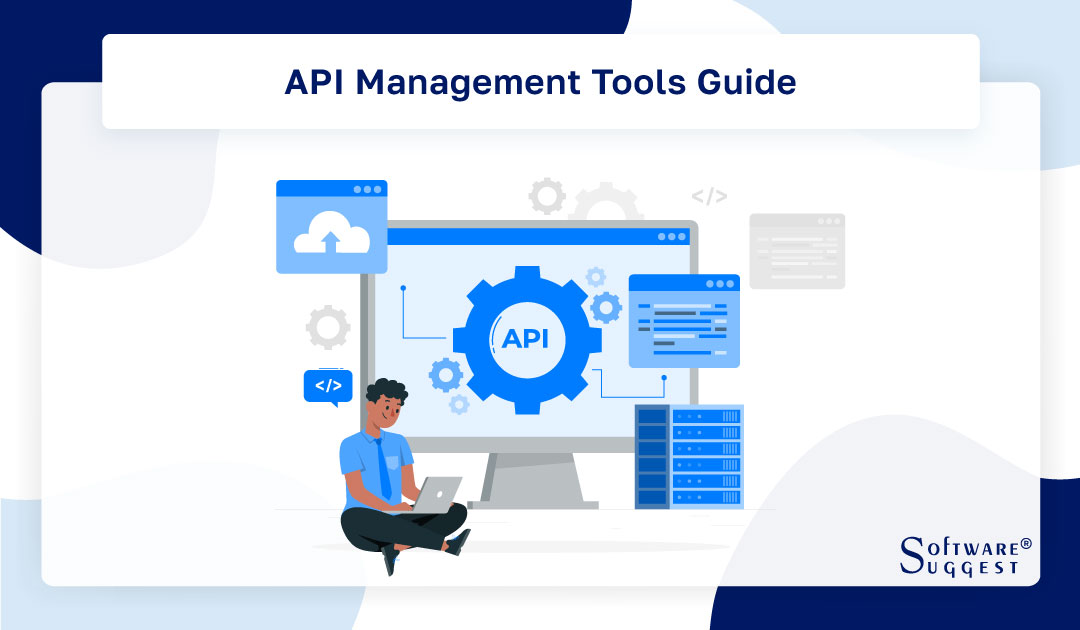
The foundation of hi-tech software development is APIs, which are the backbone of development and enable seamless system integration and communication. Application programming interface (API) management is how a company develops, monitors, and manages APIs in a safe and scalable environment.
API management tools are essential for businesses that want to manage their APIs effectively. These tools help businesses monitor, control, and monetize their application program interfaces (APIs) in a secure development environment.
With so many API management tools available in the market, it can be challenging to choose the right one. Today, we will comprehend the details regarding the API lifecycle management tools with insight into their features, pricing, and reviews. So let’s get started.
What is an API Management Tool?
Before understanding the API management tool, let’s briefly discuss API management. The methodology of managing API functions such as designing, releasing, documenting, analyzing, and monitoring APIs in a secure environment is known as API management.
Companies may ensure the security and usability of their internal and external APIs by implementing an API management platform. Now, let’s talk about what an API management tool is.
The API management solution is software testing tool that helps businesses create, deploy, monitor, and secure their APIs. Furthermore, they offer a centralized platform for controlling an API’s entire lifecycle, from conception to deactivation. In addition, such tools provide a variety of features and functionalities that accelerate the development of APIs, increase security, and boost performance.
Who Uses API Management Platforms?
Many stakeholders involved in the API lifecycle are catered to by the API management software. Some key users of API management platforms include:
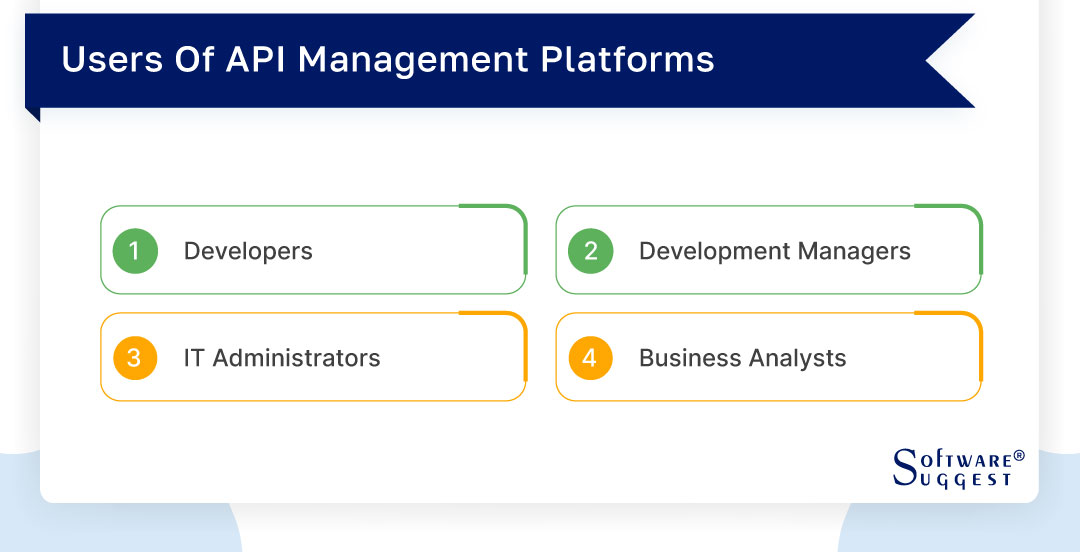
-
Developers
Best API management tools offer developers the allied interfaces to create, test, and deploy APIs. Additionally, these tools help with API versioning, documentation, and debugging, which streamlines the development process.
-
Development Managers
To supervise the API lifecycle, monitor performance indicators, and guarantee adherence to companies' standards, development management depends on API management solutions.
-
IT Administrators
IT administrators are responsible for managing access control, implementing security measures, and monitoring API traffic. This leverages them to set usage limits, enforce authentication mechanisms, and handle scalability requirements.
-
Business Analysts
Business analysts mainly focus on keeping track of key performance indicators and evaluating how APIs are affecting organizational objectives. For business analysts, API tools offer analytics and reporting abilities, allowing them to gain insight into API usage, identify trends, and make data-driven decisions.
Features of API Management Tools
A variety of features are available in the best API management software to speed up the creation and administration of APIs. Some characteristics that the best API management platforms share are:

-
API Editing
The creation of API specifications, the definition of endpoints, and the documentation of API functionality are all features that management tools frequently offer to help with API design. They might support the well-liked RAML or OpenAPI (previously Swagger) formats for API descriptions.
-
Traffic Control
API management solutions providers offer the ability to modify and transform API requests and responses. The system and version capabilities include functions like message transformation, payload modification, content type conversion, and data mapping.
-
API Monitoring
API solutions offer the handling and reporting of errors and exceptions that arise during API interactions. To facilitate debugging and troubleshooting, they might provide features like error logging, error code mapping, exception handling, and customizable error messages.
-
Automation
API development, versioning, testing, and retirement are just a few of the API integration processes that can be automated thanks to API management tools. To have seamless API updates and automated procedures, tools are integrated with DevOps tools and continuous integration and continuous improvement (CI/CD) pipelines.
-
Reporting and Analytics
API tools track and analyze API performance, usage patterns, and trends. It is one of the robust reporting and analytics features. They frequently allow users to create custom reports based on particular metrics, filters, and periods, in addition to providing pre-built reports and dashboards. These insights assist businesses in finding bottlenecks, maximizing API usage, and making data-driven choices.
Benefits of API Management Tools
Numerous advantages provided by these tools help businesses and developers succeed. The following are some major benefits of utilizing API management tools:
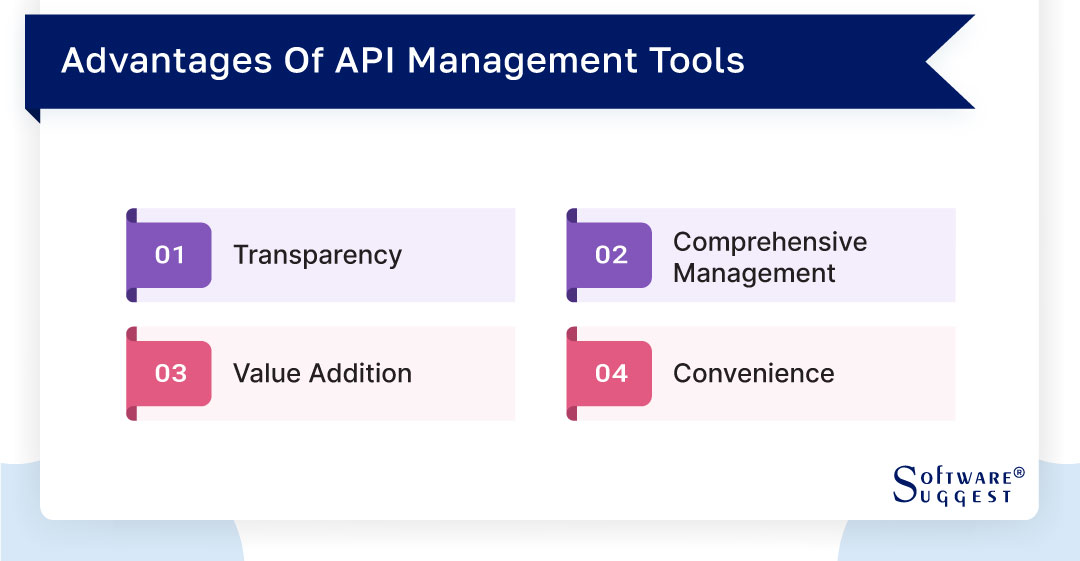
-
Increased Security and Control
API security testing tools offer improved security safeguards and access control. By enabling authentication and authorization mechanisms, you can make sure that only approved users or programs can access your APIs. In addition, these tools provide rate limiting, throttling, and monitoring functions to safeguard your APIs against misuse, unauthorized access, and potential security risks.
-
Scalability and Performance Optimization
API management tools aid in improving the scalability and performance of your APIs. They give you the ability to track usage and performance metrics for your APIs, enabling you to spot and fix any bottlenecks or problems. To make sure that your APIs can handle increased traffic and provide users with high-performance responses, these tools frequently offer caching mechanisms, load balancing, and request routing capabilities.
-
Enriched Productivity
Tools for managing APIs provide features that improve productivity and developer engagement. You can publish comprehensive documentation, code samples, and interactive API consoles on their developer portals or documentation platforms. These portals shorten the learning curve for developers and speed up the development process. Additionally, some tools provide collaboration features like API testing and versioning to help teams unite and speed up the development process.
-
Analytics and Insights
The tools offer insightful analytics about the use and performance of APIs. It gathers information on user behavior, API calls, and other pertinent metrics, which you can examine to learn insightful things. By understanding user behavior patterns, underutilized APIs, making informed decisions about API improvements, and even spotting potential business opportunities, these insights can be very useful. With the help of these tools' analytics features, you can evaluate the effectiveness and influence of your APIs on your overall business objectives.
-
Cost and Time Savings
API tools can help with cost savings and speed up development. These tools do away with the requirement for custom-built solutions or manual API management procedures by offering a centralized platform for managing APIs. Additionally, these tools frequently offer pricing plans based on how often you use your APIs, allowing you to adjust your costs in line with the actual demand for your APIs.
How To Choose The Right API Management Solution?
The market for APIs is crowded with various tools that offer extensive features and functionalities. Choosing a reliable API management solution for your product development process is a crucial stage for the organization. Some key aspects to keep in mind while choosing an API management tool are:
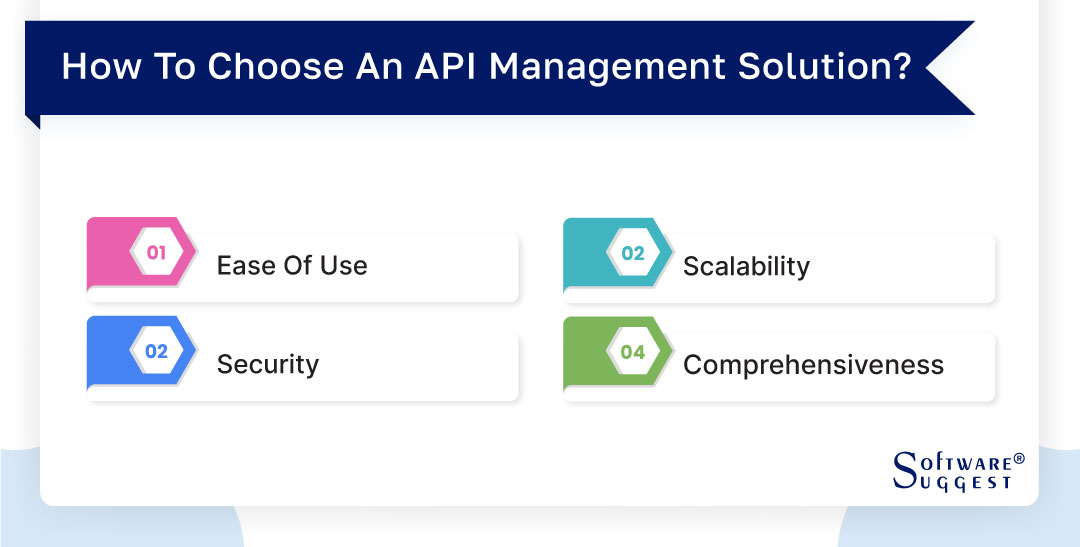
-
Ease of Use
To make the API management solutions easy to use for developers and administrators, look for a user-friendly interface and intuitive workflow. For a seamless onboarding process, take into account whether thorough documentation, tutorials, and support resources are readily available. Also, don’t forget to analyze the accessibility of self-service features that enable developers to effectively manage their APIs.
-
Scalability
Make sure the API management solution's scalability capabilities can accommodate your organization's present and future API traffic demands. To accommodate increased API usage while maintaining performance, take into account features like load balancing, caching, and horizontal scaling. According to the requirements of your organization, look for a solution that can be scaled across a variety of environments, such as on-premises, in the cloud, or in hybrid configurations.
-
Security
When choosing an API management solution, security should be given top consideration. Review the solution's authentication and authorization features, including things like OAuth support, API keys, and role-based access control. To ensure that sensitive data is protected, take into account whether the solution complies with industry standards and laws.
-
Features and Functionality
Examine the API management solution's depth of features and functionalities. Seek out capabilities for managing the entire API integrations, including API design, development, testing, deployment, monitoring, and versioning.
Check whether developer portal features like interactive documentation, code samples, and sandbox environments are available to improve the developer experience and engagement. Think about a system's ability to be seamlessly connected and interoperable with other technologies and systems through integration.
-
Vendor Support and Ecosystem
Be sure to take into account the API management vendor’s standing, level of experience, and customer support. An ecosystem of API management solution users that is vibrant and active can offer more resources, opportunities for knowledge sharing and collaboration. Examine the vendor's roadmap and commitment to ongoing product development to ensure the solution is up to date with new trends and technologies.
List of Top 5 API Management Tools Comparison
|
Name
|
Free Trial
|
Demo
|
Starting Price
|
|---|---|---|---|
| 30-days |
Yes |
Starting price at $83/month | |
|
14-days |
Yes | Starting price at $12//user/month | |
|
7-days |
Yes |
Custom Pricing | |
| 14-days |
No |
Custom Pricing | |
|
14-days |
Yes |
Starting price at $39/month |
Let's compare API management tools after understanding API lifecycle management and its features, advantages, and difficulties. The top five API management tools are as follows:
1. IBM API Connect
IBM API Connect is a product built for DevOps, offering a single connector to all APIs and web services. It is one of the top API management tools and enables you to combine data from various sources into a single main location or database. Across various clouds, this tool is used to secure and manage APIs at all stages of development. For the entire API management lifecycle, this tool is among the best.
Key Features
- API management
- Role based access control
- Cloud connectors
- Reliable architecture
Pros
- From a single developer portal, it manages the complete API cycle.
- The simple and easy-to-use user interface.
- The platform is more secure and reliable than others.
Cons
- Some user reviews mention a lack of product documentation.
- Small business owners find it difficult to afford it due to its high cost.
Pricing
- The pricing includes various tiers, starting with free trials.
- Base Tier: USD 83/ month
- Advanced Tier: USD 2280/month
2. Postman

With real-time customers, over 25 million developers use Postman. It is one of the world's most famous API management products. The main goal of Postman as an API platform is to allow you to create and use APIs. Postman improves collaboration and simplifies each phase of the API lifecycle, allowing you to design better APIs faster.
Key Features
- Deployment control
- Access control based on role
- User groups
- Token scanning
- Audit logs
Pros
- It is a popular, intuitive and simple-to-use testing solution.
- The platform features a navigable user interface.
- The team workspaces feature enables developers on the same team to collaborate and share documentation on an API project.
Cons
- Postman does not support other APIs well, such as SOAP; only RESTful APIs are supported.
- Some Postman users reported crashes or slowdowns from the software, as well as high memory usage.
Pricing
- It is free to sign up and then offers a three tiers pricing model.
- Basic: $12/per user per month
- Professional: $29/per user per month
- Enterprise: Custom pricing
3. Workato
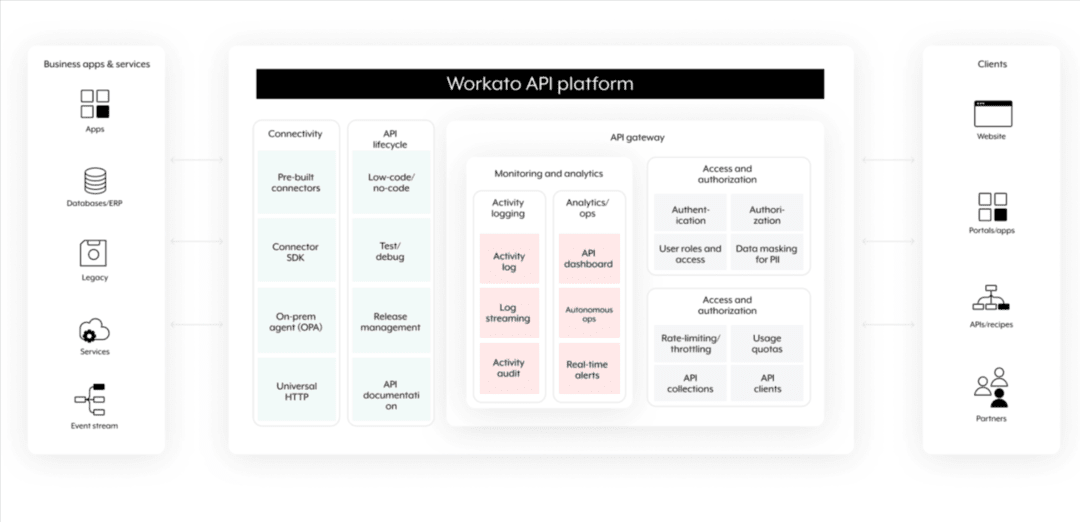
Workato is a smart automation platform that lets you integrate multiple technologies with your APIs and increases operational efficiency. It is useful for teams with inexperienced or citizen developers who must participate in the automation design process.
Key Features
- Low-code integration
- User groups
- Enterprise-level workflow automation
- On-premises agent
Pros
- Workato has a beginner-friendly approach with low codes and no codes.
- It allows users to easily move records from one SaaS application to another.
- The platform is highly cost-effective, resulting in better overall ROIs.
Cons
- The learning curve can be a bit steep for beginners.
- Some of the integrations are seemingly still in the testing phase.
Pricing
- The platform provides custom pricing.
4. Mulesoft Anypoint Platform

MuleSoft's Anypoint Platform is yet another top API platform for linking apps and data throughout the API life cycle. Furthermore, using an open, pluggable architecture that permits extensive integration into current systems and cloud services, the platform gives secure access to data and services. It is also based on open standards, allowing organizations to integrate with any application.
Key Features
- Workflow automation
- Low code integration
- Role based access control
- Rapid API development
Pros
- It allows developers to prepare and design their applications.
- It is very simple to use and user-friendly.
- Because Anypoint is Java-based, it is an excellent alternative for teams who have experienced Java programmers.
Cons
- Mulesoft's integrated development environment (IDE) tool is Eclipse, and Eclipse has high memory usage and slowness tendencies that may impede developers from working on large projects.
- When mapping occurs, Mulesoft does not retrieve metadata from databases.
Pricing
- MuleSoft's Anypoint platform offers a free trial with a customized pricing model.
5. Stoplight

With a design-first approach, you can create successful API programs of any size that achieve business outcomes. Stoplight is the only API solution that focuses on design. The Stoplight platform promotes consistency, reusability, and quality for a delightful development experience through integrated documentation and governance.
Key Features
- API modeling tools
- HTTP request creator
- Interactive API Mocking
- API transformation
Pros
- The platform has OpenAI support for better efficiency.
- It is capable of seamless GIT integration.
- Stoplight API offers extensive Markdown support.
Cons
- It struggles to provide easy support for multiple environments.
- Although setting up Stoplight is not difficult, there are tools that are easier to set up for testing endpoints.
Pricing
- Three users can sign up for free, after which there are pricing plans.
- Basic: $39/ per month
- Starter: $79/ per month
- Professional: $319/ per month
Challenges of API Management Tools
Despite their many benefits, they also have unique difficulties. Let's examine some typical issues and how API management solutions resolve them.
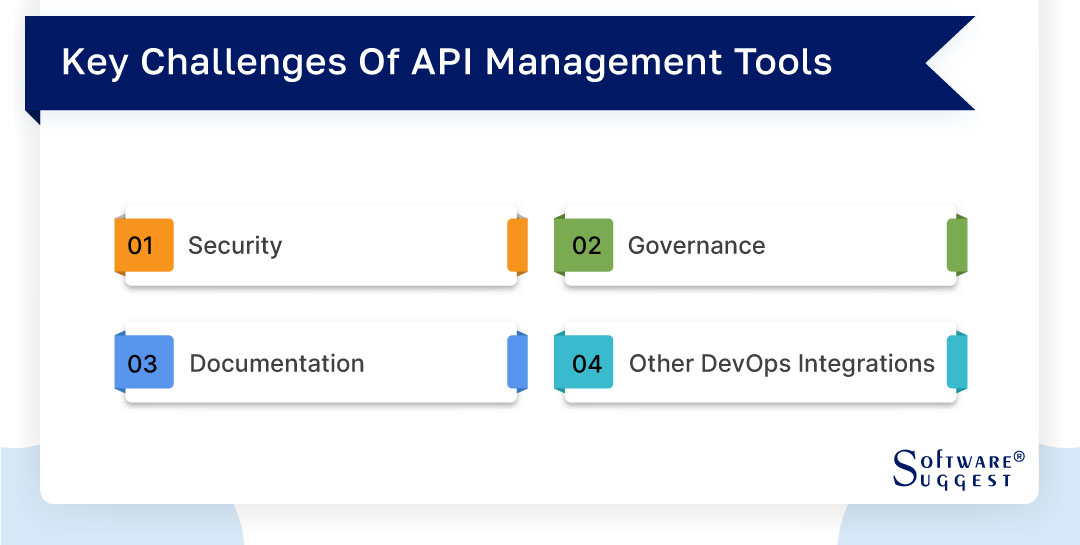
-
Security
Some of the common challenges that need to be faced include ensuring authentication and authorization management, preventing potential attacks and vulnerabilities, uploading encryption, and access control. When your business is getting ready to scale API management operations, security must always remain a top priority.
-
Governance
Well, these tools are also entwined with the policies, like other IT tools and resources. The ideal procedure for establishing consistent governance API guidelines and standards for the organization with API governance tools gets underway as soon as API development begins. Also, managing the downline and upgrading the API versioning by keeping track of API usage and compliance.
-
Documentation
To ensure that your API is properly utilized, documentation is essential. Offering top-notch documentation that is in line with the current codebase makes sense to make their lives simpler. A developer portal can be made available to accomplish this.
Developer portals are designed to present your API endpoints, terms of usage, community resources, and, ideally, a live chat in an easy-to-read style.
-
Technological complexity
The difficulty of API integration is perhaps the most frequent but not the least significant issue that can arise. Adopting API technology necessitates a redesign of internal systems as well as KPIs, security, and governance standards, as well as data management and integrity.
-
Cost and time consumption
API management tools can be relatively expensive at first but are an investment in the future. In addition to the application itself, the cost of employing talented developers and paying for the staff may go beyond your budget. Over time, support and maintenance costs may increase.
-
Scalability
During the development process, scaling infrastructure and maintaining high API traffic loads is difficult. Additionally, issues with load balancing and effectively distributing traffic can occasionally arise. The areas where the scalability of the API management platforms may be tested include maintaining the queue, managing demand spikes, and ensuring high availability.
Latest Trends in API Management Tools
API management solutions are enhancing their space with the support of rising technology. Here are the top five trends for API management tools:

-
Low code and No code API Management
Low-code/no-code API management is an approach that enables automated code generation through visual building blocks like drag-and-drop and pull-down menu interfaces. This trend is offering user-friendly interfaces and visual development environments that help beginners integrate APIs successfully.
-
Cloud Native API Management
Cloud-native API management is a way of managing APIs that operates natively to manage your entire cloud-native digital ecosystem. It offers a layer of mediation, abstraction, analytics, and systems simplification. With the rise of cloud computing, cloud-native architectures and technologies are the new models for API management.
-
API First Design
API-first design is a software development approach in which the API is designed and documented before any other part of the application. By employing an API-first design pattern, a single-source-of-truth artifact is documented before writing a single line of code
This approach places a focus on creating APIs as the first thing to take into account when creating applications. It entails creating APIs that are user-friendly for developers, well-documented, and simple to use for integrations by outside developers.
-
API-as-a-product
One of the latest trends gaining popularity is API-as-a-product. This API approach treats an API as a product rather than just a means of communication between different apps. API-as-a-Product is a type of Software-as-a-Service that monetizes niche functionality, typically served over HTTP. Tech companies with API products often adopt a freemium model and utilize strategies like rate limiting to enable subscription tiers.
-
Serverless architecture
Serverless architecture (also known as serverless computing or function as a service, FaaS) is a software design pattern where applications are hosted by a third-party service, eliminating the need for server software and hardware management by the developer. It is a cloud computing that lets you operate apps and services without managing or provisioning on-premise servers. This allows you to concentrate on developing your application rather than worrying about server upkeep.
Conclusion
For businesses looking to optimize their API development, deployment, and management procedures, selecting the appropriate API management tool is essential. Examine your needs, take into account elements like scalability, security, and comprehensiveness, and choose a tool that fits them.
Maintain up-to-date knowledge of the most recent developments in API management tools to maximize these developments and improve your API-driven initiatives. Investing in the best API management platform will surely give your organization a key competitive advantage and streamline operations.
By Countries























.png)